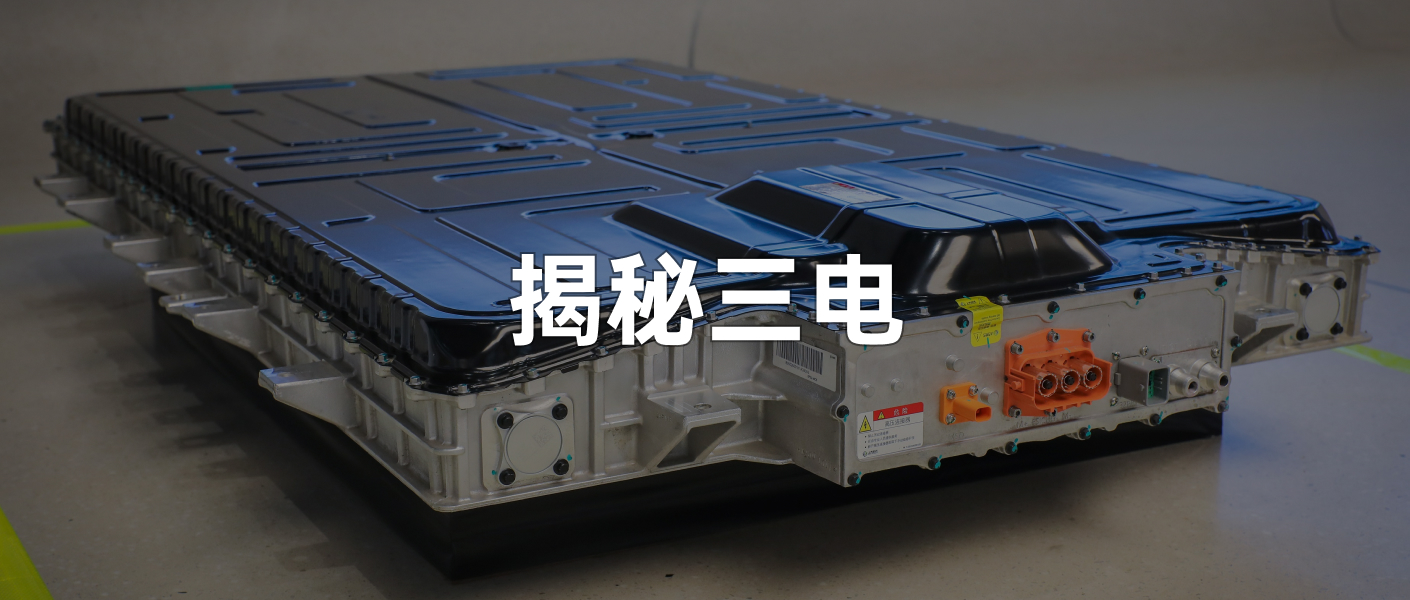“We still pursue the comprehensive and versatile champion, not the one that excels at a particular aspect, but with all-around strength.”
“Our characteristic is pursuing balance, safety, reliability, and durability.”
Not long ago, at SAIC’s media communication meeting for three-electricity, Zhu Jun answered the differences between SAIC and other brands on three-electricity. In Zhu Jun’s view, breaking the balance to get the strong point will bring the weakness on the other end.
Here I want to remind you all not to make a mistake, the Zhu Jun who said this is not the CCTV host, but the Deputy Chief Engineer of Shanghai Automotive Group Co., Ltd., Vice Director of SAIC Technology Center, and General Manager of Jieneng Company, the core figure of SAIC three-electricity.
Talking about balance, I think Tesla Model 3 on the current market is a very good positive example. It balances power, endurance, and cost very well. As an electric car, if the performance is excellent but the endurance is too short, or the endurance is long but the price is expensive, or it is cheap but very unsafe, it cannot become a popular product in the market. However, the market demands for “balance” are very high, and different consumers have different needs. Once there is a weak point, they will lose a part of the users. But it is not easy to take care of multiple aspects at the same time. To support the product power of balance, there must be comprehensive technology. This is also the direction that SAIC is striving for in the field of three-electricity, and according to the current situation, SAIC has achieved phased results.
E0, E1, E2 Three Steps of SAIC Electrification
I think many readers are unfamiliar with the three-electricity level of SAIC, which is understandable because this aspect has been rarely mentioned and promoted before, and has not gained much popularity. And people tend to question the unfamiliar things habitually, which is fine. The following content will give you a more comprehensive understanding of SAIC’s three-electricity. And the contents involved here will be more interesting and even unconventional, such as the 180 Wh/kg grouping density produced under the 523 formula, the electric drive system with a clutch, the coaxial structure of the driving motor, and the high-efficiency electric drive system with a top speed of 185 km/h, etc. The technology part will be relatively long, and readers interested in this part can browse it carefully.
Before talking about the three-electricity of SAIC, let me first talk about the cornerstone that carries the entire “electric” part, which SAIC divided into three stages, E0, E1, and E2.
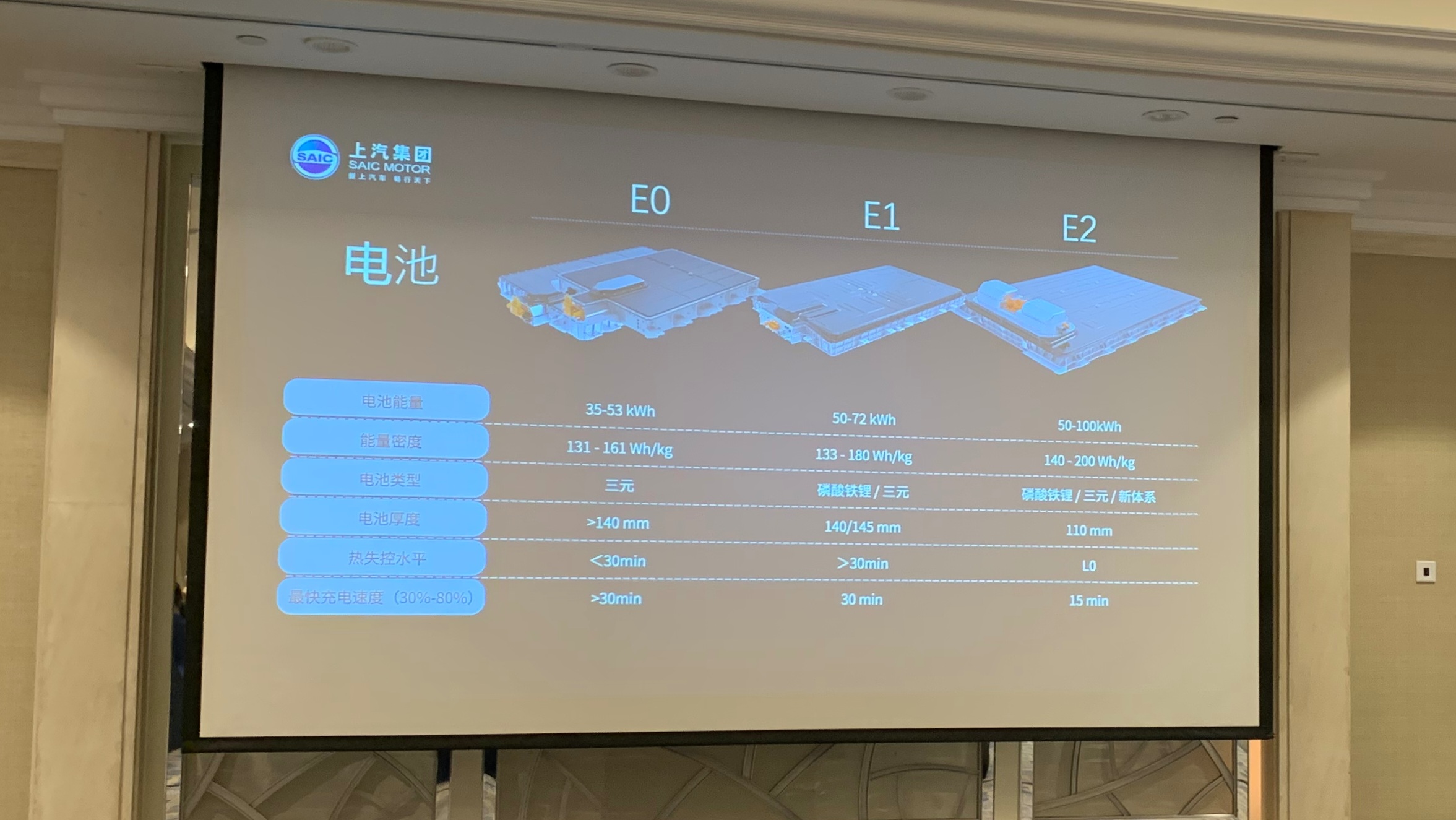
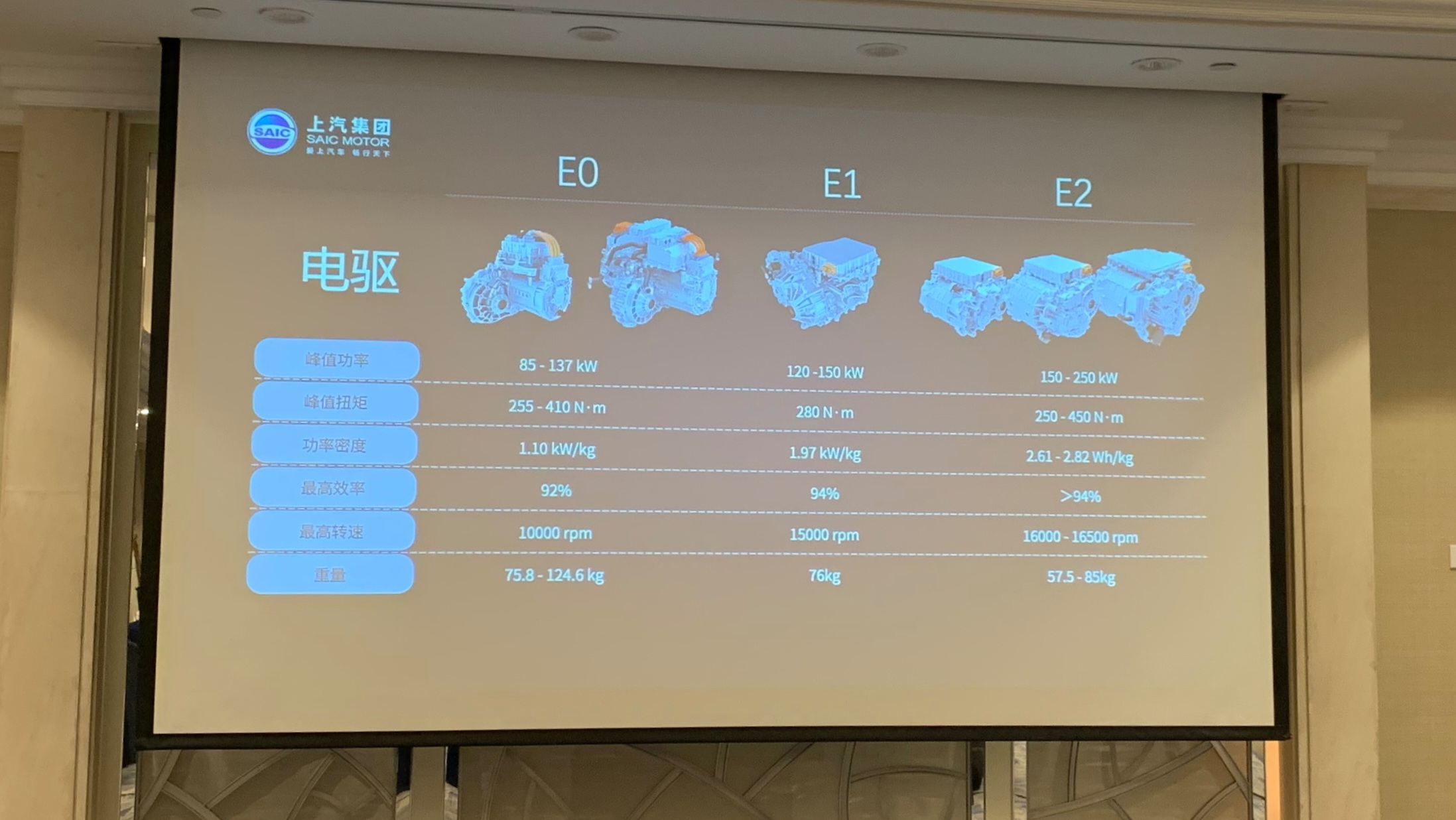
These three stages also correspond to the past, present, and future in the application of the product. Let’s focus on the present and future regarding the technology, and there is no need to review the technology of the past too much.
The differences between E0, E1, and E2 stages in three-electric lies primarily in the electric drive system, the battery part, and the whole vehicle platform. In general, the later the stage, the electric drive system has higher energy efficiency, higher integration, and larger power density (from both quality and volume aspects). As for the battery, the later the stage, the larger the capacity, the thinner the thickness, the better the safety, and the closer the interchangeability of specifications. For the whole vehicle platform, there will be an exclusive pure electric platform in the E2 stage. The contents of the battery and electric drive systems in SAIC’s three-electric are the focus of today’s discussion.
A Closer Look at Three-Electric
High-density battery with a safer formula
“Up to now, our batteries except for the cell technology, which is procured from suppliers, mainly use Ningde Times and A123’s cell technologies. Other battery technologies are independently developed by SAIC.” This is the first sentence Zhu Jun said about the battery. Due to independent research and development, SAIC has made a significant difference in the battery part compared with peers.
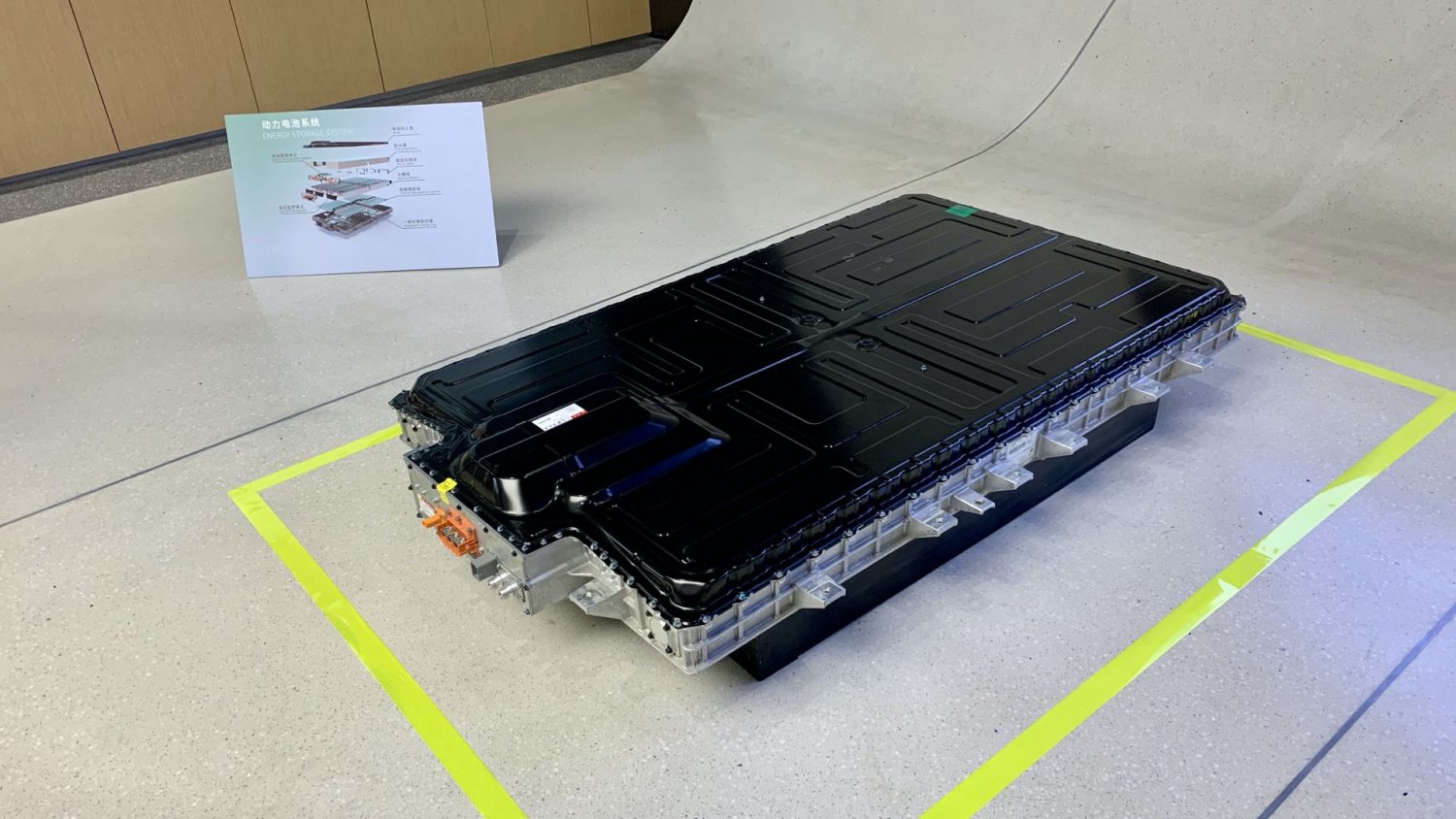
Do you still remember the 72.7 kWh battery pack on the SAIC R brand ER6? With this battery pack, the ER6 achieved an NEDC range of 620 km, which is very close to the 668 km long-range version of the Tesla Model 3 and ranks first in compact sedans.
The highlight is that the energy density of its battery pack reached 180Wh/kg. What’s more important is that this density was achieved under the 523 battery formula, which has a lower energy density compared to the 811 formula. It shows how much contribution was made by the “group” part to achieve a higher battery pack density than the 811 formula.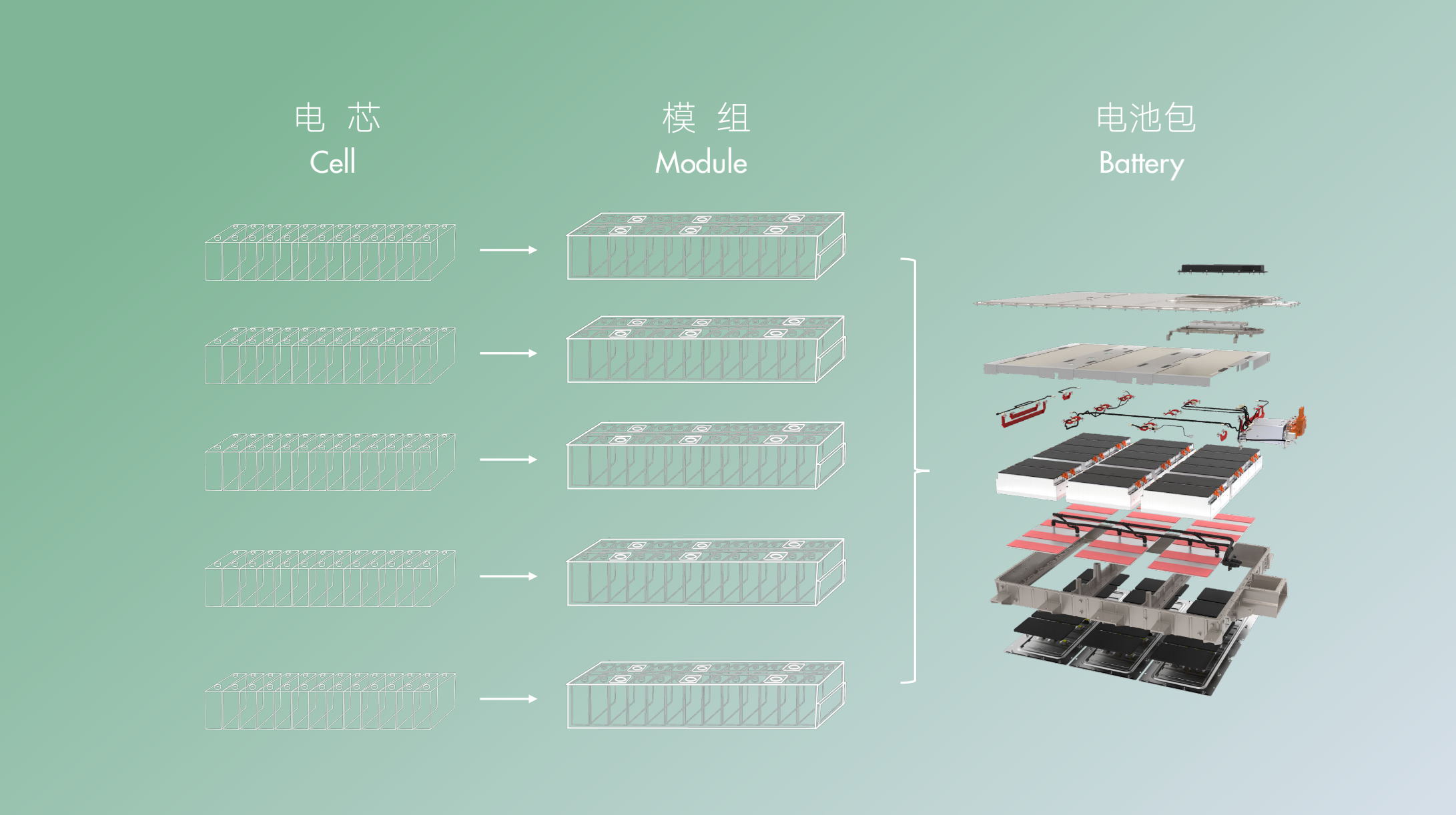
According to SAIC’s data, the current mainstream 523 battery pack has a volume utilization rate of about 40-50% and a mass utilization rate of 65-75%. In other words, nearly half of the volume and one-third of the weight of the final battery pack are not used for energy storage.
One reason for this issue is that the battery pack is made up of multiple modules. The structure of the modules includes not only the battery cells, but also other functional and protective components, which take up a certain amount of volume and mass. To put it less seriously, a battery pack is like a big box, the module is like a small box with foam cushioning inside the big box, and the battery cells are like eggs in the small box. If a certain method can be used to minimize the use of packaging boxes while ensuring that the eggs are not broken, more eggs can be packed into the big box.

SAIC has done just that. By customizing a large module solution, SAIC reduced the number of modules in the battery pack to six, which means less “packaging” for battery cells. As a result, the new battery pack has a 34% increase in volume energy density and a 15% increase in mass energy density. In more intuitive terms, the original volume could only hold 54.3 kWh of battery, while now it can hold 72.7 kWh.
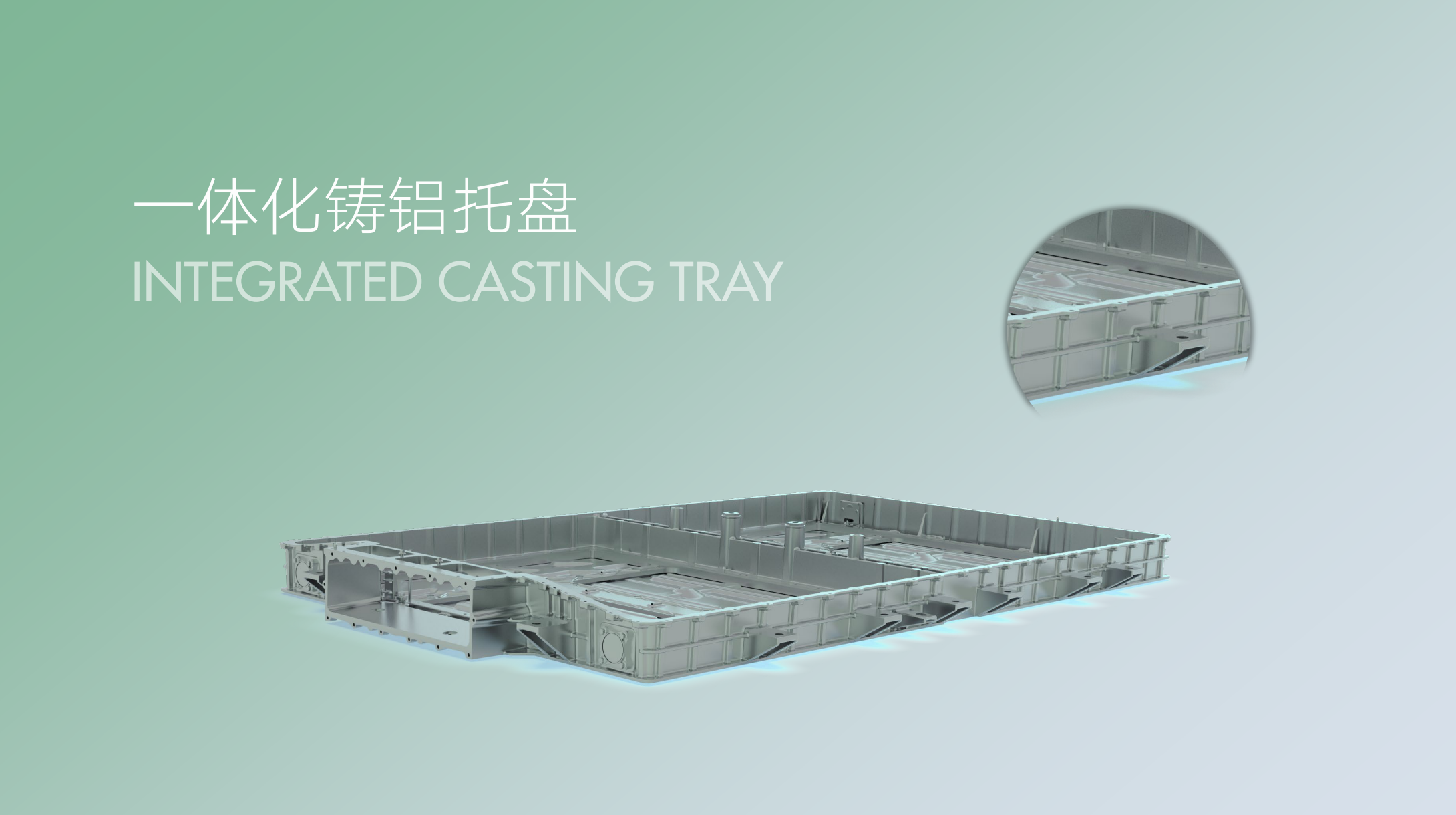
During this process, SAIC also made an industry-unique integrated cast aluminum tray for this battery pack, reducing the weight of this single part by 17 kg. Moreover, the innovative manufacturing processes and materials used have also reduced the production cost of this part, making it both excellent and inexpensive.The concern about high-density lithium batteries and safety is reasonable since generally speaking, the safety of high-density lithium batteries is somewhat poorer. Not only the public is concerned about the safety incidents of power batteries, but the country has also begun to take action. Recently, the Ministry of Industry and Information Technology issued the national mandatory standard GB 38031-2020 “Safety requirements for power batteries for electric vehicles”, which clearly requires that the battery system not catch fire within five minutes after the cell becomes thermally uncontrollable. This mandatory national standard will be implemented from January 1st next year. However, SAIC’s battery pack is designed in accordance with the American UL-2580 battery safety standard, which is currently the strictest durability standard for batteries. The thermal runaway management standard is 30 minutes. In order to test, SAIC deliberately “burnt” fifty to sixty sets of battery packs, some of which did not experience thermal runaway, only cell failure, and the battery packs were not damaged. The worst thermal runaway occurred at about 40 minutes, which was longer than 30 minutes.
However, the above are all passive protection assessment standards for lithium battery safety after thermal runaway. Generally speaking, the safety of lithium batteries at this stage has been doing well, and the probability of thermal runaway resulting in fire is not as high as people imagine. Especially with the 523 formula used by SAIC, which is relatively mature and safe, and its chemical properties are relatively mild. However, safety always requires redundant considerations, even if thermal runaway occurs, it must be able to respond. In Zhu Jun’s words, SAIC has sacrificed a lot of energy density and cost to achieve such a level of thermal runaway management, using various means such as plugging, prevention, dispersion, explosion-proof valves, and aerogels.
A lot of efforts have been made both in terms of thermal management and passive protection. Sealing the battery pack alone took a lot of effort. The sealing of the battery pack not only requires the host factory to have the ability, but also has requirements for suppliers. SAIC, together with companies such as DuPont and Dow Chemical, finally achieved IP69k level of sealing for the battery pack.
What’s more?The size of the battery pack for the E1 phase has only one specification, which is 1690mm * 1100mm * 140mm. In addition to the 72.7 kWh pack for the ER6, there are also two other capacities, 63 kWh and 53 kWh. The 53 kWh version uses a lithium iron phosphate battery, which has cost advantages. The purpose of having multiple capacities in one battery pack is for battery swapping.
This unified specification for the battery pack is not only for the E1 phase, but also for the E2 phase. With this unified specification, we may see rechargeable, swappable, and upgradable batteries in SAIC’s products. Zhu Jun even mentioned the short-term rental model. For example, if a user needs to make a long-distance trip, they can go to a 4S store to swap for a battery with a larger capacity, and return it a few days later. Of course, Zhu Jun also said that this idea is only a concept and the final implementation depends mainly on market demand.
The E2 batteries will “completely surpass” the E1 batteries in terms of density, capacity, and safety. In SAIC’s plan, the risk of thermal runaway and fire for the E2 batteries will be zero, and the maximum capacity will be close to 100 kWh.
The thickness of the 140mm battery pack for the E1 phase is one of the few regrets. For the E2 phase, the thickness will be reduced to 110mm. Some may wonder if a thicker battery can hold more capacity. Yes, but the thicker the battery, the harder it is to make the car chassis thin and the more difficult it is to have a lower stance. In order to balance the appearance and functionality, the battery needs to be thin. However, for a 72.7 kWh battery that can fit into a compact car, 140mm is already a good level.
Regarding the first 8-layer hair-pin motor in China, the cruising range of electric vehicles mainly depends on two things, battery size, and energy consumption. The 72.7 kWh battery is already a good foundation for the ER6’s cruising range, and the driving system is also responsible for its 620 km NEDC range. In addition to the battery, SAIC has also made many innovations in the electric drive system. Although the power of the motor on the ER6 seems ordinary, there are actually several worth mentioning innovations unseen by the naked eye.One of the improvements is the stator with 8 layers of Hair-pin windings. To give a brief introduction, the rotor of a permanent magnet synchronous motor is made of permanent magnets, while the stator generates a magnetic field by passing current through windings, and the interaction between their magnetic fields achieves the driving force for rotation. To some degree, the larger the current passing through the windings, the stronger the driving force, and the smaller the resistance of the windings, the higher the energy efficiency. To increase power density and energy consumption levels, all motor manufacturers are trying to cram as much copper wire as possible into the limited space.
Hair-pin is a type of winding for the stator of the motor, which is commonly known as “clip-on”. Compared with the traditional winding method of cylindrical enamel wire, Hair-pin adopts flat wire design, which can place more copper wire in the original space of the stator, greatly increasing the “slot fill factor”.
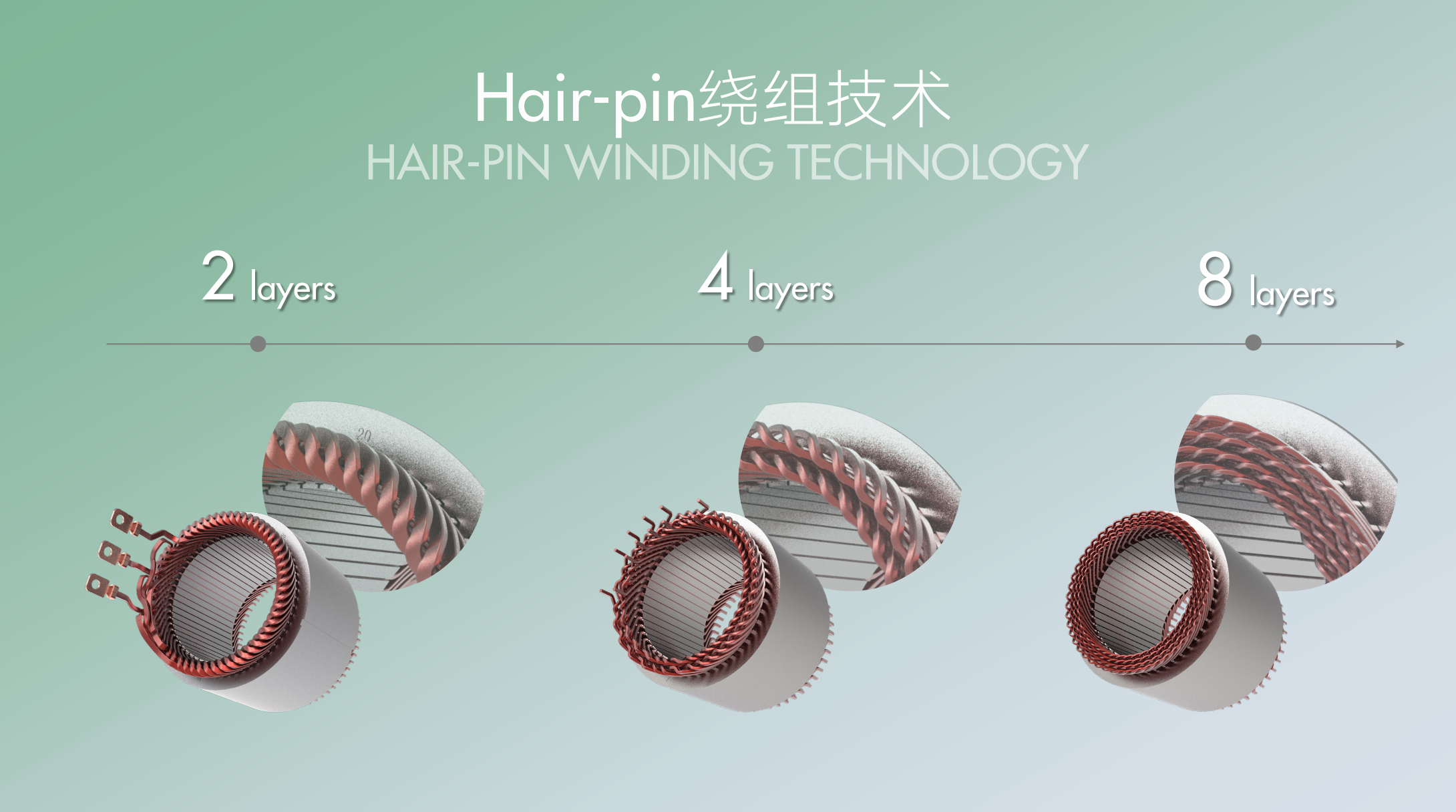
On the other hand, SAIC has made this winding 8 layers thick, which increases the surface area of the copper wire. When AC current passes through the wire, there is a significant skin effect, and a larger surface area of the wire has less resistance, resulting in improved efficiency.
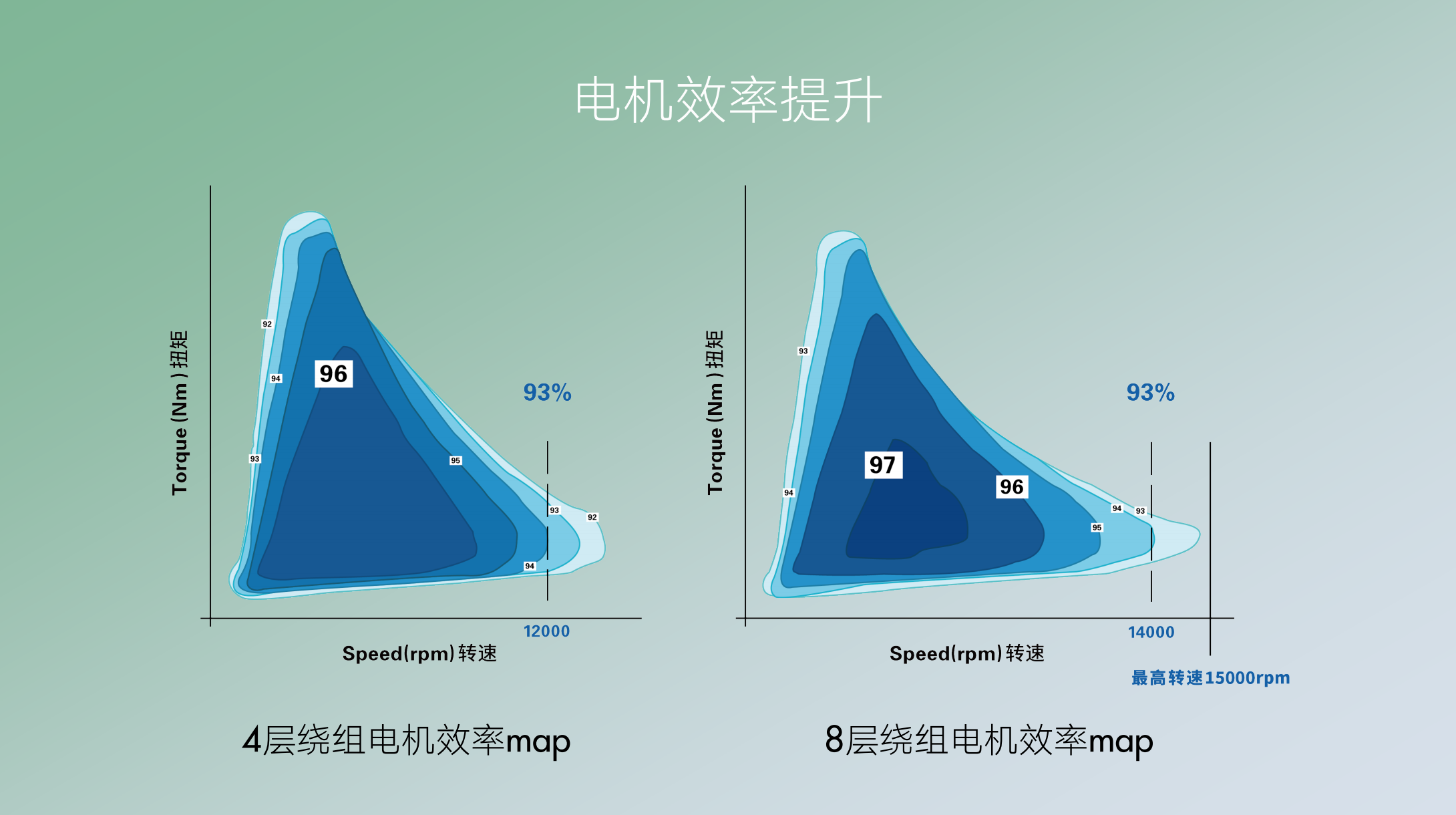
With such technology, the ER6 motor has achieved a high level of efficiency, with an efficiency of 93% even at a rotational speed of 14000 rpm, and a maximum efficiency of 97%.
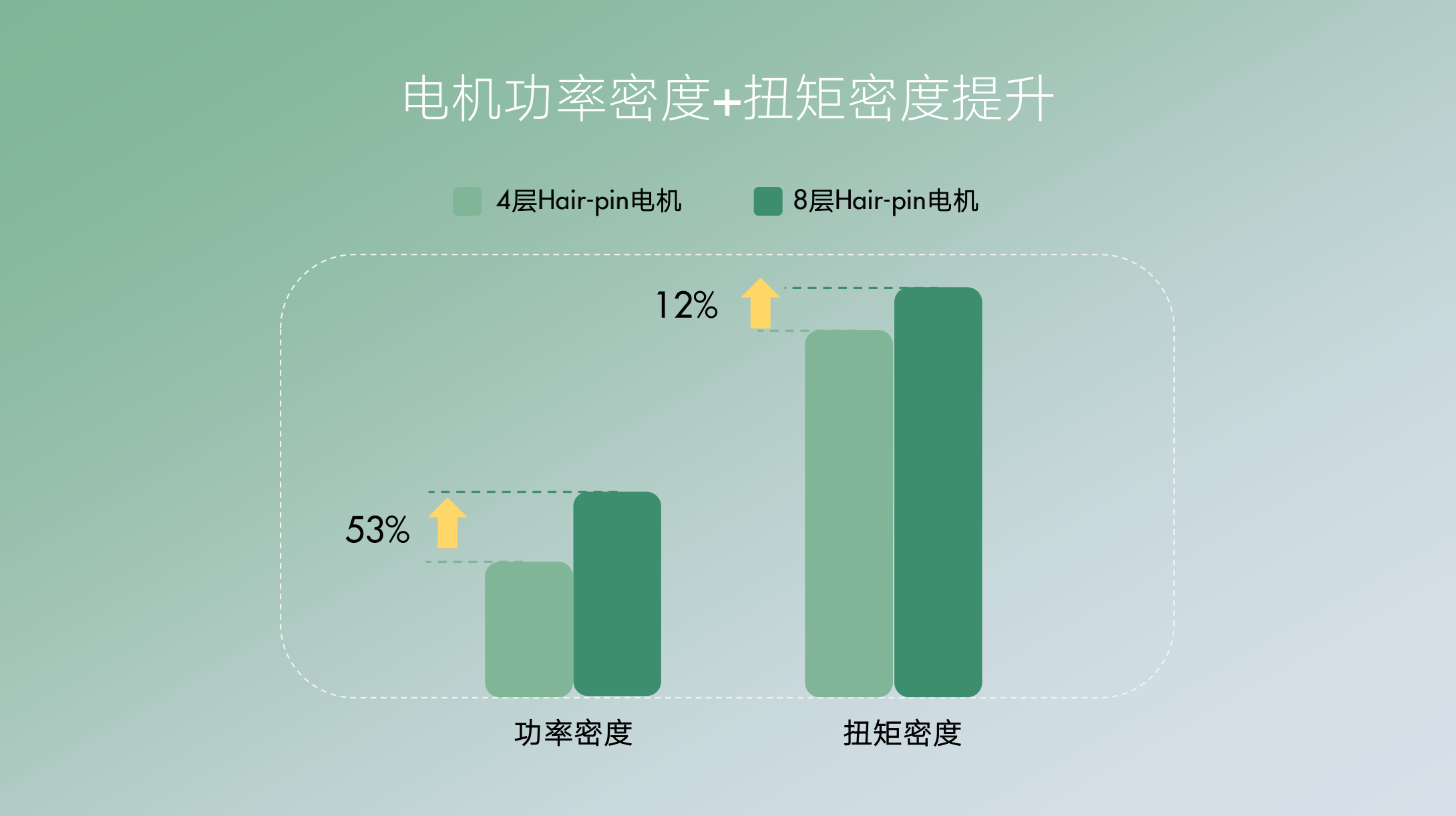
You may not have much concept of this data, so to put it simply, compared with a motor with 4 layers of Hair-pin windings, which was already advanced in China, this motor reduces energy consumption by 11.5%, and the overall average energy consumption of the ER6 is 12.2 kWh/100 km.
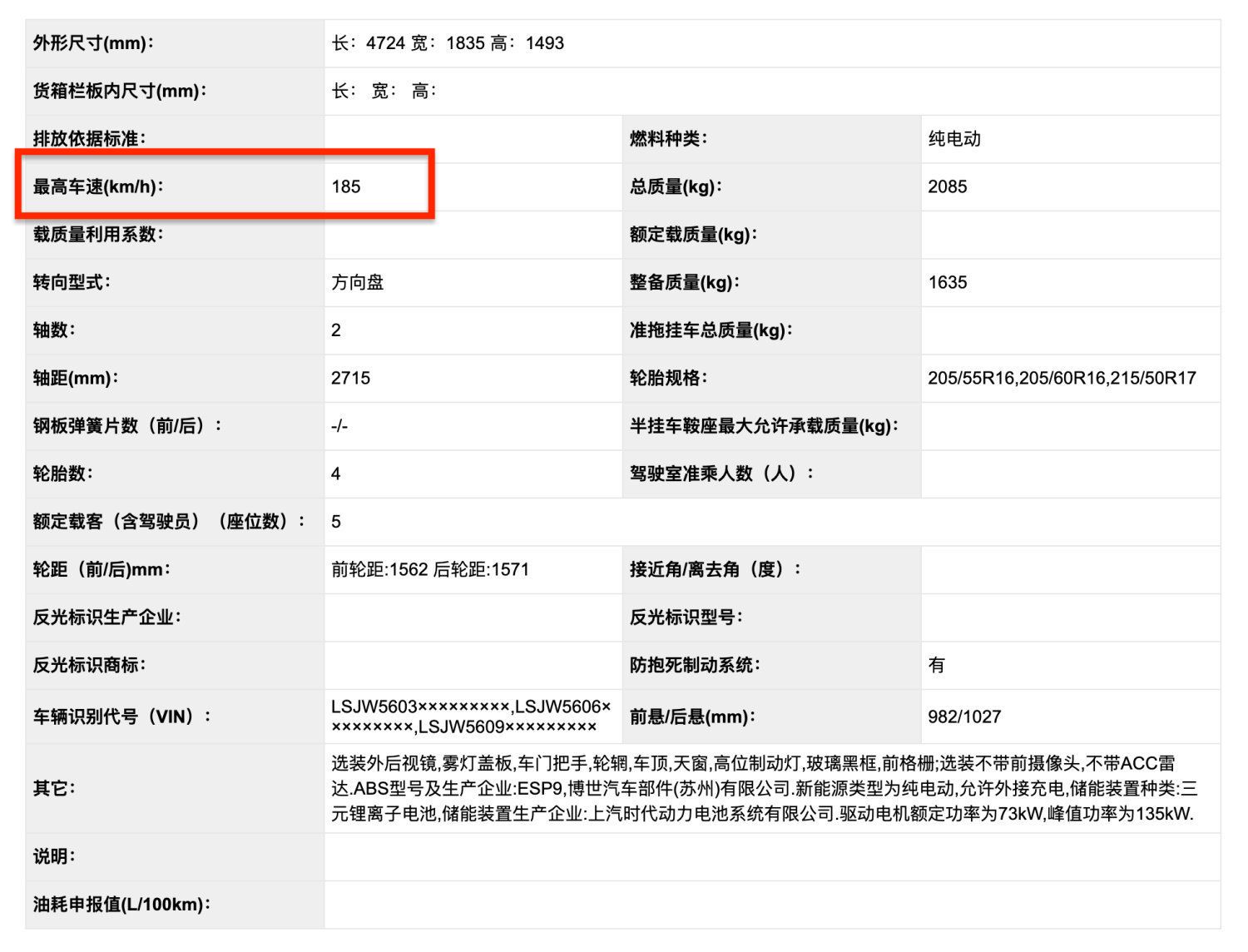 This electric motor has an important feature worth noting. Its gear reduction ratio is less than 10, making the top speed of the ER6 exceed 180 km/h. What’s more, the ER6’s motor has a maximum rated speed of around 15000rpm, while the motor speed at 120km/h is only around 9000 rpm, which is still in the range of high energy efficiency. With an aerodynamic coefficient of only 0.24 Cd, the ER6 has outstanding energy efficiency during high-speed cruising, which is an advantage of the ER6 over its peers.
This electric motor has an important feature worth noting. Its gear reduction ratio is less than 10, making the top speed of the ER6 exceed 180 km/h. What’s more, the ER6’s motor has a maximum rated speed of around 15000rpm, while the motor speed at 120km/h is only around 9000 rpm, which is still in the range of high energy efficiency. With an aerodynamic coefficient of only 0.24 Cd, the ER6 has outstanding energy efficiency during high-speed cruising, which is an advantage of the ER6 over its peers.
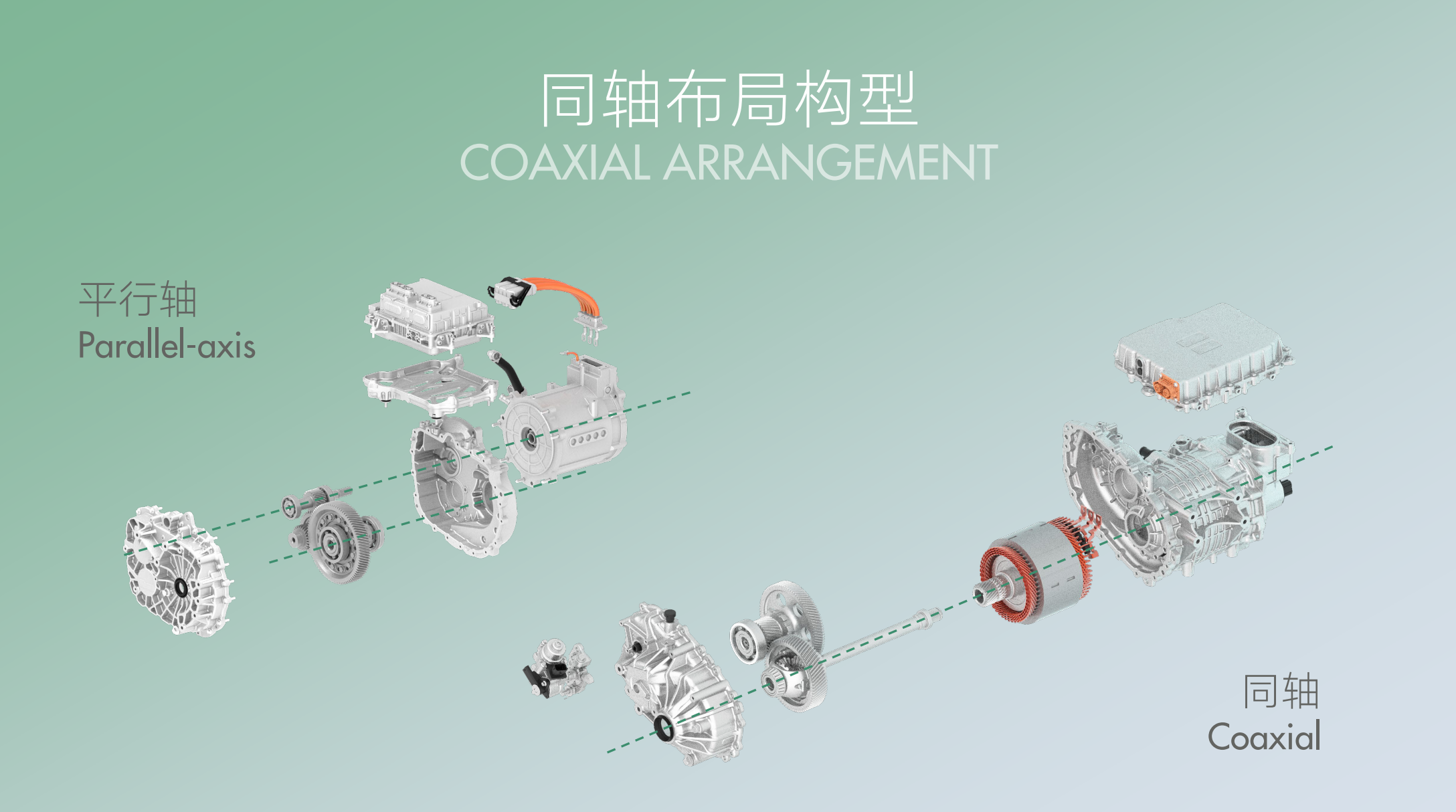
Another innovation in SAIC’s electric drive system is the adoption of a coaxial structure instead of a parallel-axis structure.
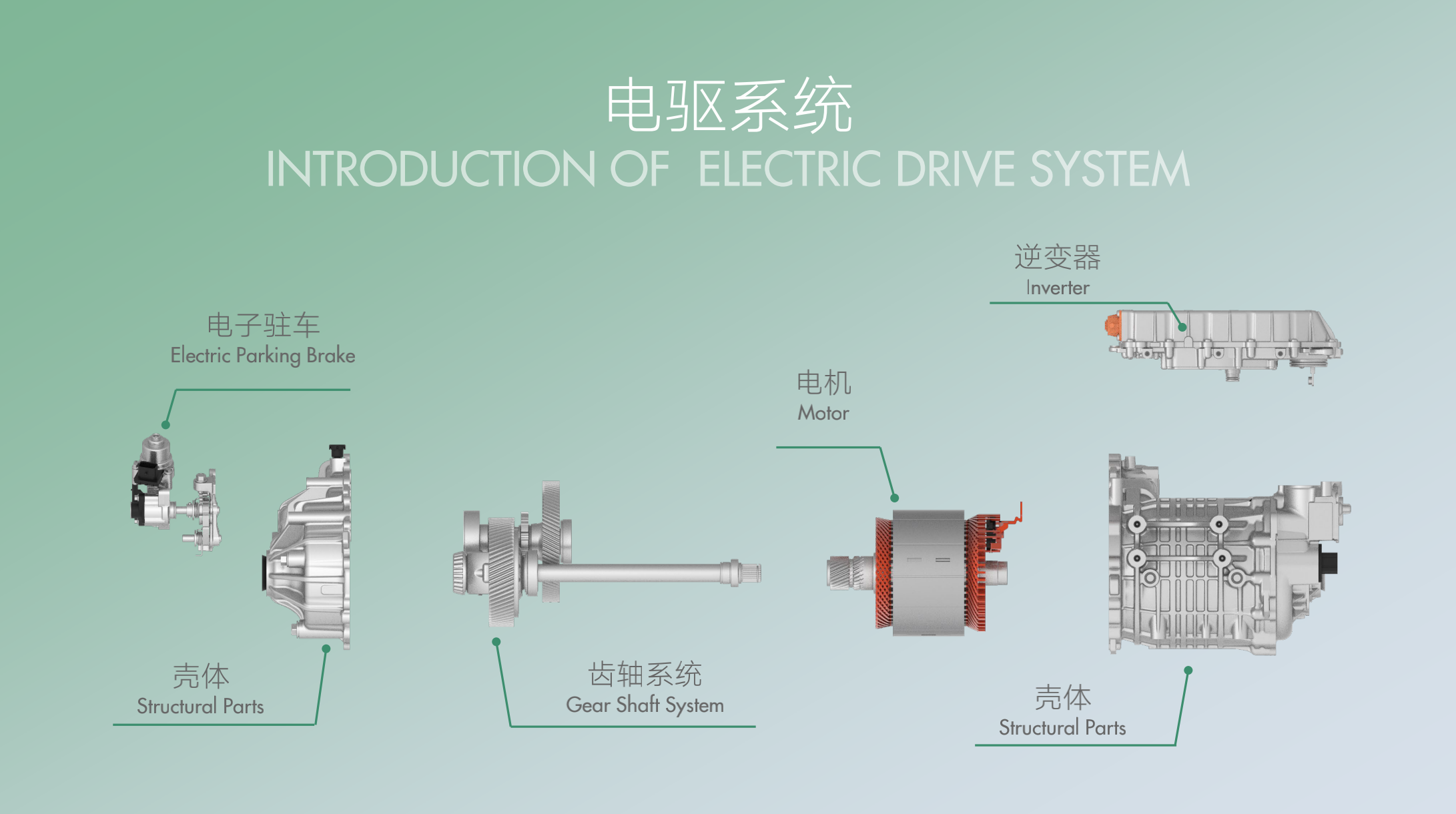
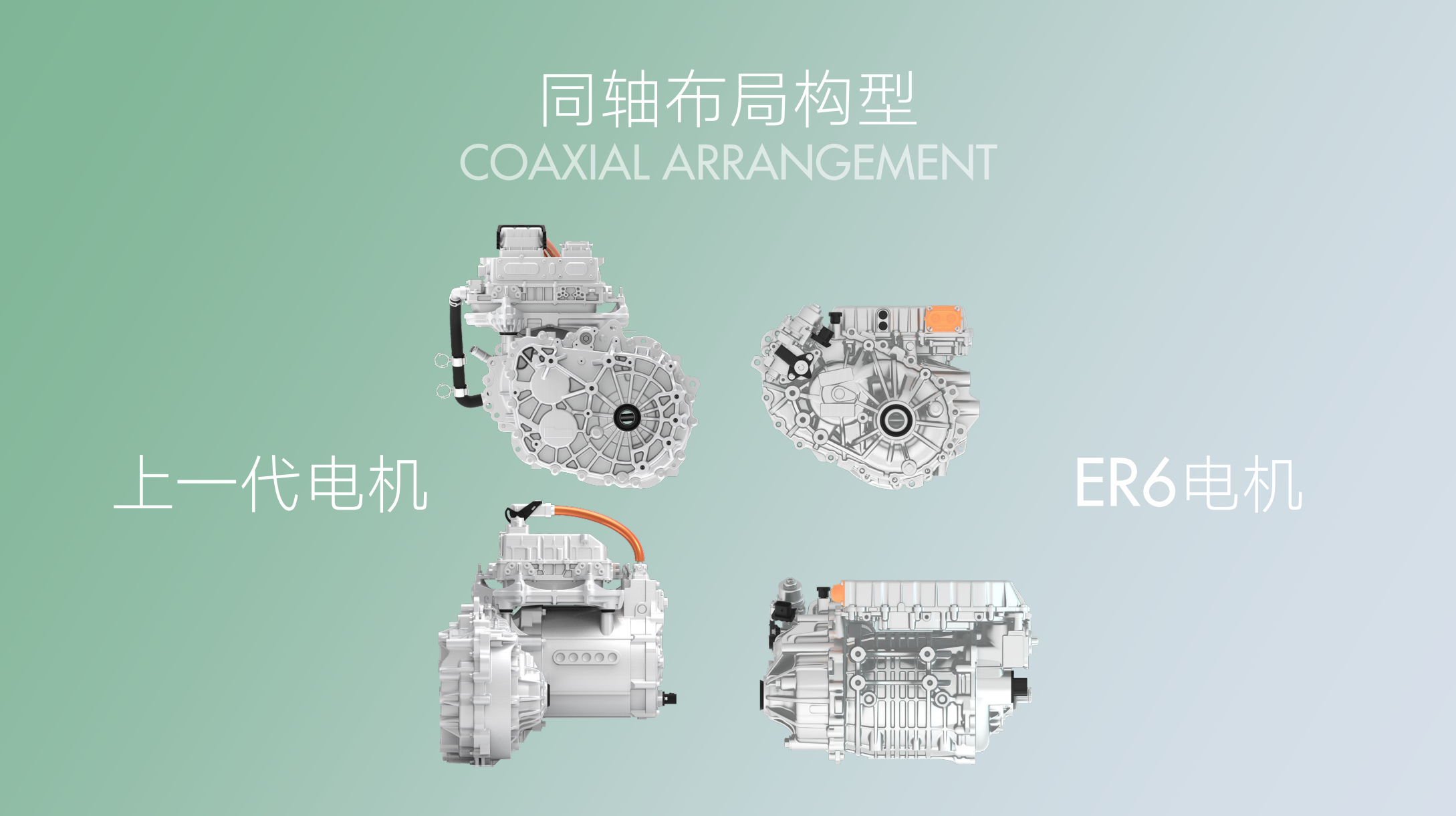
The power is transmitted from the motor rotor shaft through two sets of reduction gears to the output shaft. The output shaft rotates coaxially with the hollowed-out rotor shaft. Compared with the parallel-axis structure of the electric drive system, this structure is more compact, as can be seen from the image. A compact electric drive system requires less space, resulting in a shorter front compartment and more interior space for the same vehicle length, which is a significant advantage for front-wheel drive vehicles.
However, achieving a coaxial structure is not easy because the driving shaft of the coaxial structure must pass through the motor, which requires the motor rotor to be very compact. The motor rotor usually consists of a shaft that needs to be hollowed out to allow the output shaft with a torque of several thousand N·m to pass through the motor rotor, while ensuring the strength of the rotor shaft. Therefore, SAIC has invested a lot of effort in making this structure.
Electric cars can also have a clutch.Regarding the electric drive system, there is one aspect that may seem counterintuitive to you, and that is the clutch. In the case of multi-motor four-wheel drive electric vehicles, under light loads, only one motor is needed to drive the vehicle. However, unlike traditional fuel-powered vehicles, the other motors in an electric vehicle may still be rotating even if they are not outputting power, thus affecting the dynamic performance of the vehicle’s acceleration and deceleration due to the increased rotational inertia of the rotor and gear parts, similar to the effect of a heavy flywheel in a gasoline-powered car.
If the driven motor is an asynchronous motor, there is still some benefit, as it does not produce back electromotive force. However, if it is a synchronous motor, it can be problematic, as it not only has the same rotational inertia issue but also produces back electromotive force which creates extra resistance to the vehicle’s progress, requiring additional energy to dissipate.
One solution to prevent synchronous motors from being rotated by the wheels and causing issues is to add a clutch that allows the motor to disconnect from the axle, much like pressing the clutch pedal in a gasoline-powered vehicle. Although electric vehicle clutches are rare on the market, many manufacturers simply use whatever is available or design the simplest solution. SAIC, however, developed their own clutch solution, called the “Surpassing Clutch,” which is integrated with the bearing and only engages when the motor’s rotation speed matches that of the vehicle’s speed. Therefore, it disengages at speeds below that threshold. This process significantly reduces the impact and makes for a smoother ride while also reducing mechanical wear.
Developing the clutch was not easy, as it required a combination of hardware and control technology. SAIC had to manufacture all of the necessary parts itself, from motors and inverters to software, and it required considerable resources and effort.
In addition to the clutch, the other essential component of the electric drive system is the electronic control unit (ECU). SAIC’s subsidiary, Jieneng, is responsible for developing the ECU, and it is their top priority. Half of their resources are dedicated to the ECU, and they achieved the world-renowned ASPICE-2 level long ago. They have also begun implementing ASPICE-3 this year, a level of software reliability comparable to that of an aircraft.
As Mr. Zhu Jun, the vice president of SAIC, said, “Software capability is irreplaceable.” They take pride in the fact that everything they have designed, from the motors and inverters to the software, has been entirely their own work.
In conclusion, the electric drive system is a complex and critical component of electric vehicles, and SAIC has invested a lot of time and resources into developing and perfecting it. Although there are many aspects of the system to discuss, this provides a general understanding of the challenges involved and how SAIC has solved them.It can be said that the 620 km NEDC range achieved by the ER6 today is the result of countless efforts and hard work by SAIC. When SAIC first tried to find a supplier to make Hair-pin wound motors, they were rejected twice, but now these same suppliers have become followers of this technology.
It is hard to imagine that SAIC has achieved the same battery density and safety level as their competitors who use the 811 formula, while using the 523 formula. The data from the dynamometer test shows that the range of the ER6 is higher than 620 km. This is conservative and rigorous promotion.
As for cost, SAIC also considered it during the development process. Why not use SiC? Because using SiC would cost nearly 3,000 yuan more. In the case of the ER6, the energy efficiency improvement brought by using SiC would be equivalent to saving two charges in terms of range, but adding two charges to the cell doesn’t cost 3,000 yuan at all.
However, comprehensive cost considerations do not mean that SAIC is unwilling to invest in research and development. These are two different things. When talking about R&D investment, Zhu Jun said: “When our JET Engineers Company was founded, 40 people organized a registered capital of 2 billion yuan. Of course, there is now a lot of investment in the new energy industry chain. We also need to invest in the motor and inverter of the E2 electric axis. SAIC still has many new production lines for battery plants that require investment, worth tens of billions of yuan. Some components of our battery pack cost millions of yuan just for verification expenses.”
“If these R&D investments fail, the losses will be immeasurable. If they succeed, it will be difficult for competitors to compete with us because the entire system is in place.”
It is these investments that have enabled SAIC to produce the excellent and balanced ER6 at this level and at this price. SAIC is also striving for balance beyond the three-electric technologies. The new image of the R brand and the direct sales service system that is closer to consumers will give the new car a new era of brand temperament in the sales segment. SAIC has also established “Zero Bundle” software company to focus on the key software aspect of “software-defined car”, with an investment of billions of yuan.
In the face of industry progress and iteration, it is not enough for a company to just practice basic skills, they also need to learn new skills. From E0 to E1 to E2, SAIC has worked hard and planned carefully in the development of the three electric platforms, not just for the present, but also for the future. I believe that SAIC’s continued comprehensive investment and R&D in the three-electric field will bring more noticeable progress to its product line. This ER6 is just the beginning.
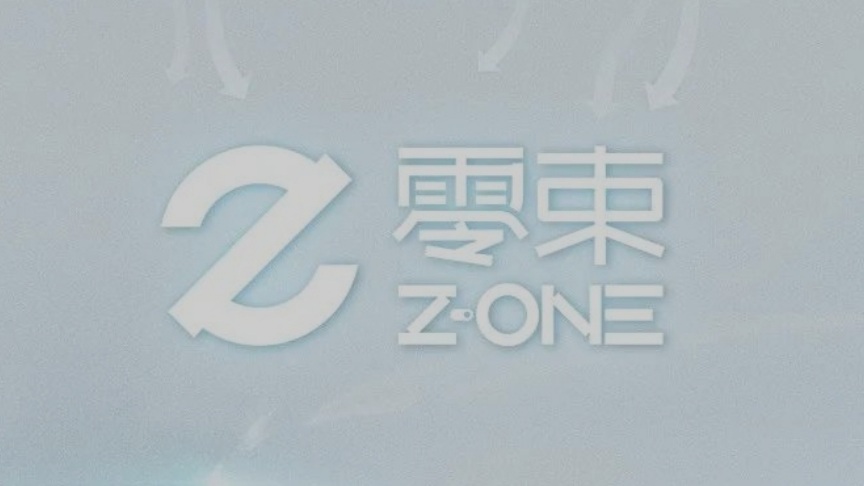
This article is a translation by ChatGPT of a Chinese report from 42HOW. If you have any questions about it, please email bd@42how.com.
